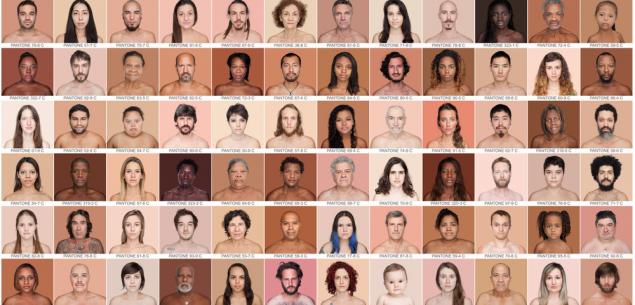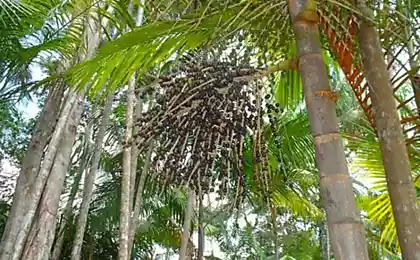532
The color of the indigenous Europeans
Part of the population is born with light skin. The birthplace of humanity in Africa, the skin color of our ancestors was dark. For a long time remained a popular hypothesis that fair skin got Europeans from Neanderthals. The DNA of Neanderthals showed that in their population really met people with different colors of hair and skin. Modern research refutes the popular hypothesis, proving that the skin color of the inhabitants of Europe began to change after the extinction of the Neanderthals. Gradually, the shade was close to modern. Now change the color of the skin explain in physiological processes.

A tall man with light skin, which well absorbs lactose, a typical description of young men of the Caucasian race. In reality, these European boys are not the same that was 8 000 years ago. Why Europeans have light skin — in the new material from Genotek.
To divide the skin of an ancient man
If you are in the company with an anthropologist, a geneticist and evolutionist, and you are bored, ask yourself: “Bred the ancestors of modern humans and the Neanderthals?” Disputes on this subject have been conducted for several decades. If you believe the research, the Neanderthals had an attractive appearance, have seen different shades of hair and skin. On the one hand, we have a lot in common with Neanderthals. DNA analysis today shows what percentage of the Neanderthal genome have in your own. Gene variants associated with the development of diseases such as diabetes and Crohn's disease, was inherited from Neanderthals. However, common features in the genome could get both us and them from a common ancestor. While the mechanism of altered pigmentation different from the one used by modern people.
To climb out of the skin to move
Having moved to Europe, people need to change the appearance and diet. The modern hypothesis is that the distribution of these characteristics in the population was motivated by a need for vitamin D. This vitamin can be produced in the skin under ultraviolet light, and may come from dairy products. So, in the course of evolution was proposed 2 solutions to the problem of vitamin deficiency. First solution: to make the skin receptive to UV light. Second solution: create an enzyme for efficiently producing vitamin from dairy products.
Veronica Musatov, consultant medical genetic center Genotek: “Vitamin D is essential for the normal formation and growth of bones. It regulates the metabolism of calcium and phosphorus. With balanced and nutritious meals and recurring exposure to the sun causes for concern. In case of appearance of signs of deficiency appear loss of appetite, insomnia, convulsions, developing osteoporosis and osteomalacia — softening of bones”.
83 ancient man
If before each new genome of the ancient man was an event, now scientists are working on genome-wide scale data of several ancient people. Anthropologists from Harvard analyzed 83 genome of ancient humans Homo sapiens archaeological sites in Europe dated from 8,000 BC to the present. The main objective of the study is to find genes that for some reason came to dominate the European population over the last 10 thousand years. For comparison used the genomes of modern Europeans from the project “1000 genomes”. The beauty of working with a genome that is a sequence of symbols to solve the number of tasks is sufficient to determine the genotype at a particular position. Just analyzed 390 000 genomic loci (individual positions in the genome). Among them only 30 000 known relationship between genotype and phenotype (outward signs).
The appearance of native Europeans
Harvard anthropologists have divided the results into 3 groups depending on the nature of the changes. “Fashion evolution” is constantly changing together with the population; “random changes” occurred irrespective of external causes, and “fundamental metamorphosis” has significantly transformed the population under the influence of natural selection. Genes belonging to the last group that has interested scientists most. They are linked to skin pigmentation and dietary habits. In the past the Europeans were dark-skinned people who do not use milk. The job of lactase in the human body began after the domestication of cattle and after the migration of the steppe tribes of the black sea pastoralists, that is, about 4 300 years ago. A change of diet has caused a demand for the development of specific physiological characteristics.
Adaptation to milk
The genes that changed with the advent of man in Europe, was associated with the metabolism. The strong pressure of selection observed at the locus, which is associated with the viability of lactase in Europeans. Replacement of only one nucleotide affects how will be synthesized this enzyme, and, therefore, the ability to digest milk sugar — lactose. Also metabolism were associated 2 gene: FADS1 and NADSYN1. The FADS1 gene is involved in the metabolism of fatty acids, and the NADSYN1 gene is associated with levels of vitamin D.
To change the color of the skin
In the new population of Europeans spread 2 gene affecting skin pigmentation, SLC24A5 and SLC45A2. Skin is a complex multifunctional organ of the human body. At the cellular level, skin pigmentation depends on the activity of melanocytes — cells that produce melanin. The gene SLC45A2 helps in creating melanin, and the gene SLC24A5 regulates calcium concentration in melanocytes. Interestingly, inhibitors (substances that inhibit the gene expression) of the last available as commercial kits for injection, skin lightening. Mutations in SLC24A5 and SLC45A2 are independently appeared in Europe around the same time. That is, at the time, as there were two independent fair-skinned populations of hunter-gatherers from Sweden and middle Eastern farmers, the General population of Europe was different from them. 8 500 years ago among hunter-gatherers from Luxembourg, Spain and Hungary were dark skin.
Alexander Rakitic, author-developer of the DNA test “Genealogy” (Genotek), exploring the genetic origin of man: “We analyzed our database and found that for the Russian population, in addition to the variant of the gene SLC24A5, which is responsible for light skin, there are other. At the same time, according to the database of the project “1000 Genomes”, in Central European populations are generally not found other options. In fact, it confirms that the population of Russians is different from the population of Europeans, and the comparison of the human genome from Russia with the genome of the world database may show substantial differences”.
Logistics eye color
Another mutation that was fixed, related to genes HERC2/OCA2. The work of these genes is associated with a delivery of dark pigment in the iris. The HERC2 gene in this case is a telephone call, and the gene OCA2 — a truck which delivers the pigment. If something is wrong on the line or transport the pigment is not delivered, and the eyes remain bright. “Default” eyes are a dark color, the lighter shades are related to the fact that the pigment is missing or does not reach the destination.
Adam, eve and I
From a conceptual point of view, this study takes us to a new level of information about the past. You can compare data of ancient people and modern and download not only the specific features of populations of the past, but also General mechanisms of evolution and adaptation in human history. The result of genotyping is the information about the genotype at the locus. The study of the evolution of the main interest is confined to changes in genotypes over time.
Restore the color of skin DNA
Modern technology of DNA analysis to complement the image of ancient people those traits that cannot be read from the skeletal remains. To recreate the contour of the face from the skull could before, now, eyes, hair and skin has color. In addition, the disclosed personal information, like metabolic properties, for example, lactose intolerance, predisposition to obesity and resistance to diseases. To build such models, researchers are working with the genome. Height, weight, chronic disease – the integrated characteristics that you can learn about a person from DNA. Dynamics of genome changes in time can be traced by comparing the data of ancient and modern people. Analyzing changes, evolutionists and anthropologists to assess the contribution of natural selection and the change in a population over a specific period of time.
Tabula rasa
These studies show that external features — means for survival. Now people are less dependent on the environment and its phenotypic traits — his own story. But skin pigmentation is not a tool, not a symbol of superiority, not special rights and not special powers. Skin pigmentation is simply a phenotypic characteristic that has varied in evolution, in connection with the adaptation to specific environmental conditions.
This material is prepared by a team of Genotek. We are engaged in genetic research. One of our projects is a DNA test "Genealogy" which tells about the origin of man, its ethnic composition and haplogroup, as well as identify the proportion of Neanderthal genome. We are actively investigating the scientific publications on the topic of human origins and will share with You the results of our work. Follow us.
Source: geektimes.ru/company/genotek/blog/282400/

A tall man with light skin, which well absorbs lactose, a typical description of young men of the Caucasian race. In reality, these European boys are not the same that was 8 000 years ago. Why Europeans have light skin — in the new material from Genotek.
To divide the skin of an ancient man
If you are in the company with an anthropologist, a geneticist and evolutionist, and you are bored, ask yourself: “Bred the ancestors of modern humans and the Neanderthals?” Disputes on this subject have been conducted for several decades. If you believe the research, the Neanderthals had an attractive appearance, have seen different shades of hair and skin. On the one hand, we have a lot in common with Neanderthals. DNA analysis today shows what percentage of the Neanderthal genome have in your own. Gene variants associated with the development of diseases such as diabetes and Crohn's disease, was inherited from Neanderthals. However, common features in the genome could get both us and them from a common ancestor. While the mechanism of altered pigmentation different from the one used by modern people.
To climb out of the skin to move
Having moved to Europe, people need to change the appearance and diet. The modern hypothesis is that the distribution of these characteristics in the population was motivated by a need for vitamin D. This vitamin can be produced in the skin under ultraviolet light, and may come from dairy products. So, in the course of evolution was proposed 2 solutions to the problem of vitamin deficiency. First solution: to make the skin receptive to UV light. Second solution: create an enzyme for efficiently producing vitamin from dairy products.
Veronica Musatov, consultant medical genetic center Genotek: “Vitamin D is essential for the normal formation and growth of bones. It regulates the metabolism of calcium and phosphorus. With balanced and nutritious meals and recurring exposure to the sun causes for concern. In case of appearance of signs of deficiency appear loss of appetite, insomnia, convulsions, developing osteoporosis and osteomalacia — softening of bones”.
83 ancient man
If before each new genome of the ancient man was an event, now scientists are working on genome-wide scale data of several ancient people. Anthropologists from Harvard analyzed 83 genome of ancient humans Homo sapiens archaeological sites in Europe dated from 8,000 BC to the present. The main objective of the study is to find genes that for some reason came to dominate the European population over the last 10 thousand years. For comparison used the genomes of modern Europeans from the project “1000 genomes”. The beauty of working with a genome that is a sequence of symbols to solve the number of tasks is sufficient to determine the genotype at a particular position. Just analyzed 390 000 genomic loci (individual positions in the genome). Among them only 30 000 known relationship between genotype and phenotype (outward signs).
The appearance of native Europeans
Harvard anthropologists have divided the results into 3 groups depending on the nature of the changes. “Fashion evolution” is constantly changing together with the population; “random changes” occurred irrespective of external causes, and “fundamental metamorphosis” has significantly transformed the population under the influence of natural selection. Genes belonging to the last group that has interested scientists most. They are linked to skin pigmentation and dietary habits. In the past the Europeans were dark-skinned people who do not use milk. The job of lactase in the human body began after the domestication of cattle and after the migration of the steppe tribes of the black sea pastoralists, that is, about 4 300 years ago. A change of diet has caused a demand for the development of specific physiological characteristics.
Adaptation to milk
The genes that changed with the advent of man in Europe, was associated with the metabolism. The strong pressure of selection observed at the locus, which is associated with the viability of lactase in Europeans. Replacement of only one nucleotide affects how will be synthesized this enzyme, and, therefore, the ability to digest milk sugar — lactose. Also metabolism were associated 2 gene: FADS1 and NADSYN1. The FADS1 gene is involved in the metabolism of fatty acids, and the NADSYN1 gene is associated with levels of vitamin D.
To change the color of the skin
In the new population of Europeans spread 2 gene affecting skin pigmentation, SLC24A5 and SLC45A2. Skin is a complex multifunctional organ of the human body. At the cellular level, skin pigmentation depends on the activity of melanocytes — cells that produce melanin. The gene SLC45A2 helps in creating melanin, and the gene SLC24A5 regulates calcium concentration in melanocytes. Interestingly, inhibitors (substances that inhibit the gene expression) of the last available as commercial kits for injection, skin lightening. Mutations in SLC24A5 and SLC45A2 are independently appeared in Europe around the same time. That is, at the time, as there were two independent fair-skinned populations of hunter-gatherers from Sweden and middle Eastern farmers, the General population of Europe was different from them. 8 500 years ago among hunter-gatherers from Luxembourg, Spain and Hungary were dark skin.
Alexander Rakitic, author-developer of the DNA test “Genealogy” (Genotek), exploring the genetic origin of man: “We analyzed our database and found that for the Russian population, in addition to the variant of the gene SLC24A5, which is responsible for light skin, there are other. At the same time, according to the database of the project “1000 Genomes”, in Central European populations are generally not found other options. In fact, it confirms that the population of Russians is different from the population of Europeans, and the comparison of the human genome from Russia with the genome of the world database may show substantial differences”.
Logistics eye color
Another mutation that was fixed, related to genes HERC2/OCA2. The work of these genes is associated with a delivery of dark pigment in the iris. The HERC2 gene in this case is a telephone call, and the gene OCA2 — a truck which delivers the pigment. If something is wrong on the line or transport the pigment is not delivered, and the eyes remain bright. “Default” eyes are a dark color, the lighter shades are related to the fact that the pigment is missing or does not reach the destination.
Adam, eve and I
From a conceptual point of view, this study takes us to a new level of information about the past. You can compare data of ancient people and modern and download not only the specific features of populations of the past, but also General mechanisms of evolution and adaptation in human history. The result of genotyping is the information about the genotype at the locus. The study of the evolution of the main interest is confined to changes in genotypes over time.
Restore the color of skin DNA
Modern technology of DNA analysis to complement the image of ancient people those traits that cannot be read from the skeletal remains. To recreate the contour of the face from the skull could before, now, eyes, hair and skin has color. In addition, the disclosed personal information, like metabolic properties, for example, lactose intolerance, predisposition to obesity and resistance to diseases. To build such models, researchers are working with the genome. Height, weight, chronic disease – the integrated characteristics that you can learn about a person from DNA. Dynamics of genome changes in time can be traced by comparing the data of ancient and modern people. Analyzing changes, evolutionists and anthropologists to assess the contribution of natural selection and the change in a population over a specific period of time.
Tabula rasa
These studies show that external features — means for survival. Now people are less dependent on the environment and its phenotypic traits — his own story. But skin pigmentation is not a tool, not a symbol of superiority, not special rights and not special powers. Skin pigmentation is simply a phenotypic characteristic that has varied in evolution, in connection with the adaptation to specific environmental conditions.
This material is prepared by a team of Genotek. We are engaged in genetic research. One of our projects is a DNA test "Genealogy" which tells about the origin of man, its ethnic composition and haplogroup, as well as identify the proportion of Neanderthal genome. We are actively investigating the scientific publications on the topic of human origins and will share with You the results of our work. Follow us.
Source: geektimes.ru/company/genotek/blog/282400/
Olayinka Noel - live copy of Princess Jasmine
At Harvard I believe I have found the physical centre of human consciousness























